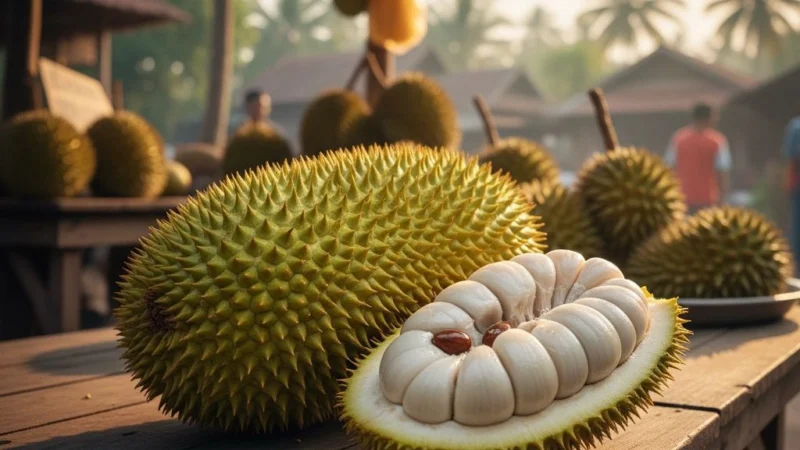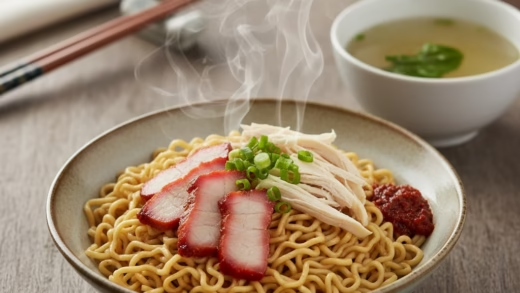Terap

Introduction
Terap (Artocarpus odoratissimus), or Wild Breadfruit, is one of Malaysia’s most captivating indigenous fruits—long celebrated in Borneo for its creamy sweetness, fragrant aroma, and cultural symbolism. Deeply rooted in the food traditions of Sabah, Sarawak, Brunei and Kalimantan, the fruit has evolved from a rural staple into a rising star of Malaysia’s modern culinary landscape.
As the demand for authentic, local, and sustainable ingredients grows, Terap is gaining renewed relevance. Its versatility, heritage value, and sensory appeal position it as a strategic ingredient for both traditional cuisine and contemporary gastronomic innovation.
Origin
Terap originates from the lush rainforests of Borneo and belongs to the Moraceae family, which includes jackfruit, cempedak, and breadfruit. Its scientific name, Artocarpus odoratissimus, emphasises the fruit’s hallmark characteristic—its intensely fragrant aroma.
Cultivated for generations by indigenous communities, Terap spread naturally across tropical lowlands through forest ecosystems and human settlement. Today, it remains an important component of East Malaysian agroforestry, prized for both its taste and ecological resilience.
Category
| Scientific Name | Family | Category | Type (Seasonality) |
|---|---|---|---|
| Artocarpus odoratissimus | Moraceae | Wild Tropical Fruit | Seasonal (Peak: Jun–Sept) |
Appearance
Terap is oval-shaped, typically 15–25 cm long, with a distinctive surface covered in soft, flexible spines. These spines give the fruit a fuzzy appearance, unlike the hard spikes of durian or the knobbly exterior of jackfruit. As Terap ripens, its skin changes from green to a light yellow-brown tone.
Inside, the fruit contains clusters of plump, glossy pods with creamy off-white to pale-yellow flesh. Each pod encases a smooth seed. The flesh is tender, custard-like, and intensely aromatic.
Popular Varieties
| Variety | Local Name | Distinctive Features | Region of Prominence |
|---|---|---|---|
| Standard Terap | Terap | Soft spines, creamy flesh, strong aroma | Sabah, Sarawak |
| Marang (Related) | Marang | Larger fruit, thicker rind, richer flavour | Sabah, Brunei |
| Pingan (Wild Type) | Pingan | Smaller size, mildly sweet, more fibrous | Central Sarawak |
Note: Marang is a closely related species often grouped with Terap for its similar aroma and culinary use.
Preparation
Terap is used in various culinary applications:
- Fresh: Enjoyed directly for its rich flavour and aroma.
- Snacks: Seeds roasted or boiled to create nutty, chestnut-like bites.
- Desserts: Used in fritters (cucur terap), puddings, and coconut-based sweets.
- Traditional Cuisine: Cooked in bamboo, mixed with rice, or incorporated into village-style dishes.
- Beverages: Blended into smoothies and artisanal fruit drinks.
Equipment
- Sharp knife
- Cutting board
- Latex-safe gloves
- Mixing or serving bowls
- Roasting tray (for seeds)
Taste
Terap delivers a complex sweetness combining:
- Honey-like depth
- Notes of vanilla and banana
- Subtle floral highlights
- Low acidity and smooth, creamy finish
The balanced flavour profile makes it ideal for both rustic and high-end culinary creations.
Texture
Its texture is soft and custard-like, with silky pods that melt easily in the mouth. The seeds, when cooked, develop a firm, nutty structure similar to roasted chestnuts.
Aroma
A signature trait of Terap is its powerful yet pleasant aroma. Its scent is:
- Sweet and floral
- Reminiscent of pandan, ripe banana, and creamy vanilla
- Noticeable even before the fruit is opened
The aroma plays a major role in its popularity across East Malaysia.
Cultural Significance
In Sabah and Sarawak, Terap is deeply woven into local traditions. It is a seasonal highlight at tamu markets, family gatherings, and celebratory feasts. Indigenous communities such as the Iban, Kadazan-Dusun, and Bidayuh regard Terap as a fruit that symbolises abundance, unity, and the connection between people and nature.
Its seasonal arrival often marks periods of communal harvesting, food sharing, and storytelling—preserving cultural memory and heritage through culinary experience.
Regional Cultivation
| State/Region | Famous For | Harvest Period |
|---|---|---|
| Sabah | Aromatic Terap and Marang varieties | Jun–Sept |
| Sarawak | Large wild-grown Terap | Jun–Aug |
| Brunei | Premium-quality, highly aromatic | Jul–Sept |
| Kalimantan | Forest-grown wild types | Jun–Sept |
Social Context
Terap is enjoyed primarily in rural and semi-urban settings and is especially popular during the fruiting season. It is commonly found in:
- Roadside stalls along village routes
- Weekly tamu markets
- Community celebrations and harvest gatherings
- Home kitchens where traditional recipes are handed down
Its seasonal nature makes it a highly anticipated treat among locals.
Nutritional Information (per 100g)
| Nutrient | Value (Approx.) |
|---|---|
| Calories | 95 kcal |
| Carbohydrates | 23 g |
| Protein | 2 g |
| Fat | 0.5 g |
| Fiber | 4 g |
| Vitamins | Vitamin C, B-complex |
| Minerals | Potassium, Magnesium |
Health Benefits
- Supports digestive health due to natural fibre
- Provides sustained energy from carbohydrates
- Rich in antioxidants for cellular protection
- Helps maintain heart and muscle function
- Boosts immunity with Vitamin C
- Promotes satiety and healthy digestion
Dietary Restrictions
- Consume with moderation if diabetic (natural sugars)
- Not suitable for individuals with latex-fruit syndrome
- Excessive intake may cause bloating
- Seeds must be cooked to avoid digestive issues
Allergens
Terap may trigger reactions in individuals with latex sensitivity or oral allergy syndrome. Mild throat or mouth irritation may occur in rare cases.
Cost
Malaysian price estimates:
- Standard Terap: RM8–RM15 per kg
- Marang-type varieties: RM12–RM22 per kg
- Wild forest varieties: RM10–RM18 per kg
Seasonality and region significantly affect pricing.
Production & Export
Terap is predominantly consumed domestically due to its delicate structure and short shelf life. However, interest is rising in:
- Frozen pulp and puree exports
- Value-added products such as chips, fritter mixes, and desserts
- Premium indigenous fruit branding
- Eco-tourism experiences tied to native fruit orchards
Emerging international demand comes from Singapore, Brunei, Hong Kong, and speciality Asian retailers.
Symbolism
Terap represents abundance, authenticity, cultural heritage, and environmental harmony. It is a symbol of the richness of Bornean biodiversity and Malaysia’s evolving culinary identity. As the market shifts toward native produce and sustainable food systems, Terap stands as a fruit that bridges tradition with future culinary innovation.








Comments are closed.